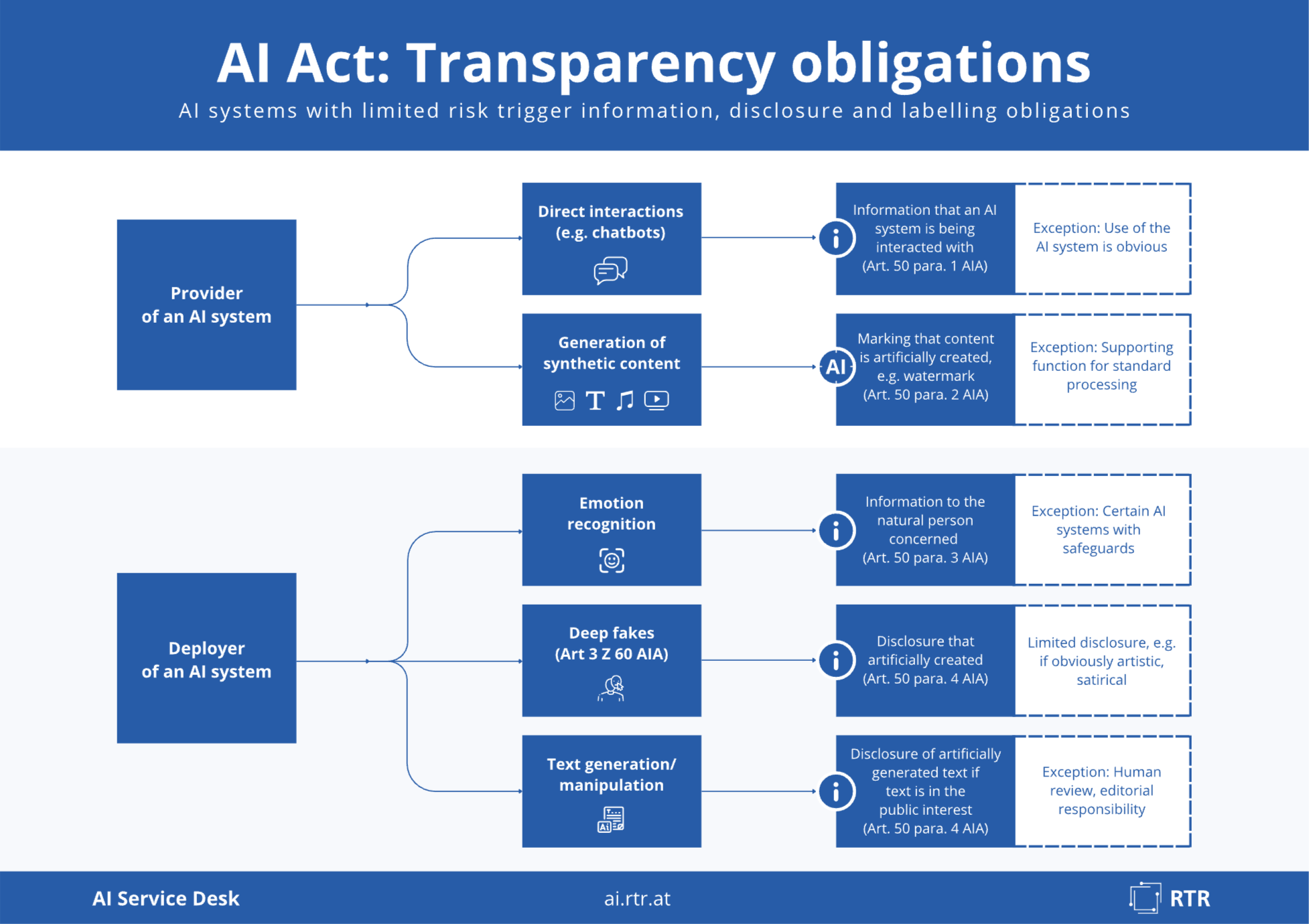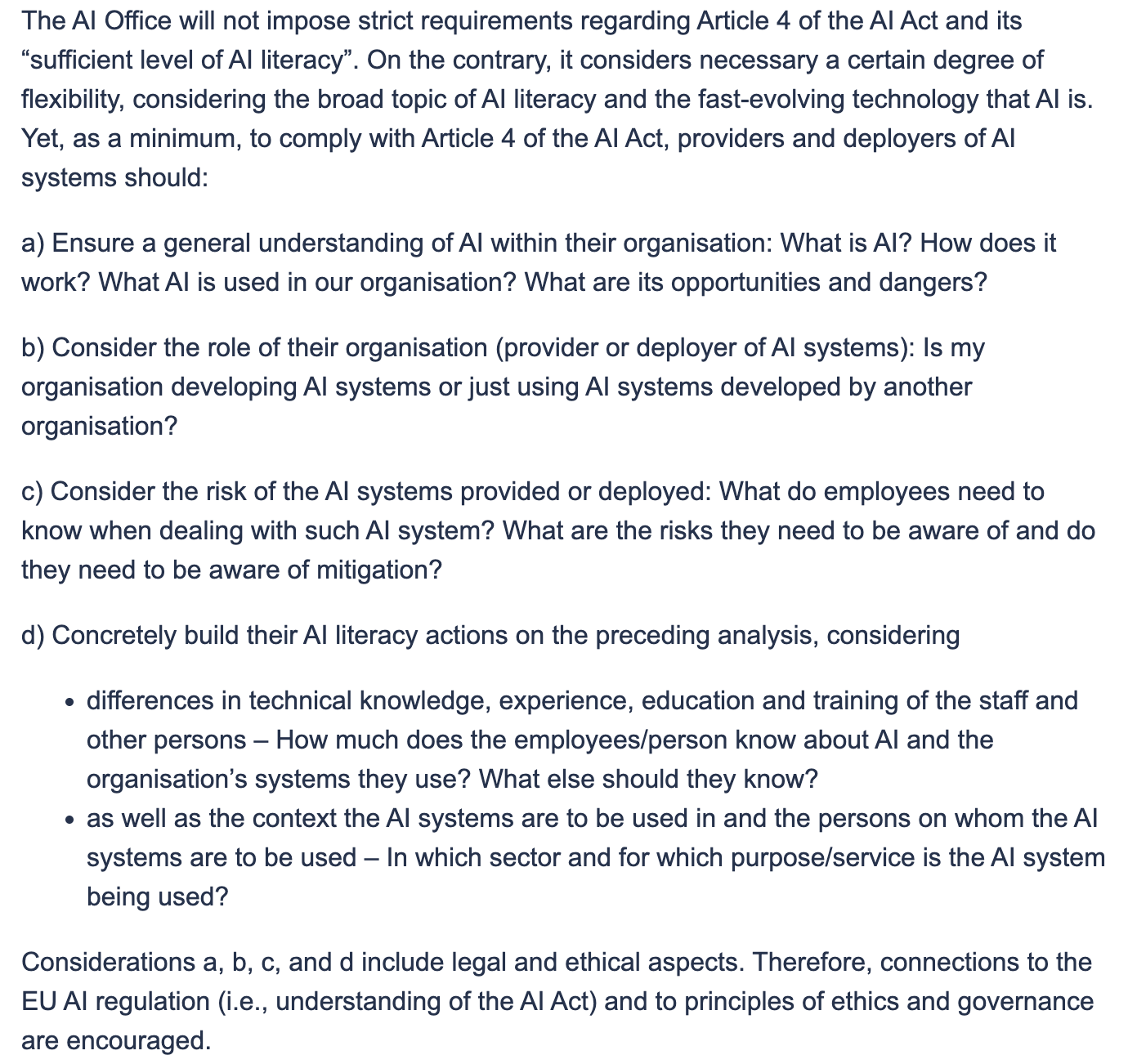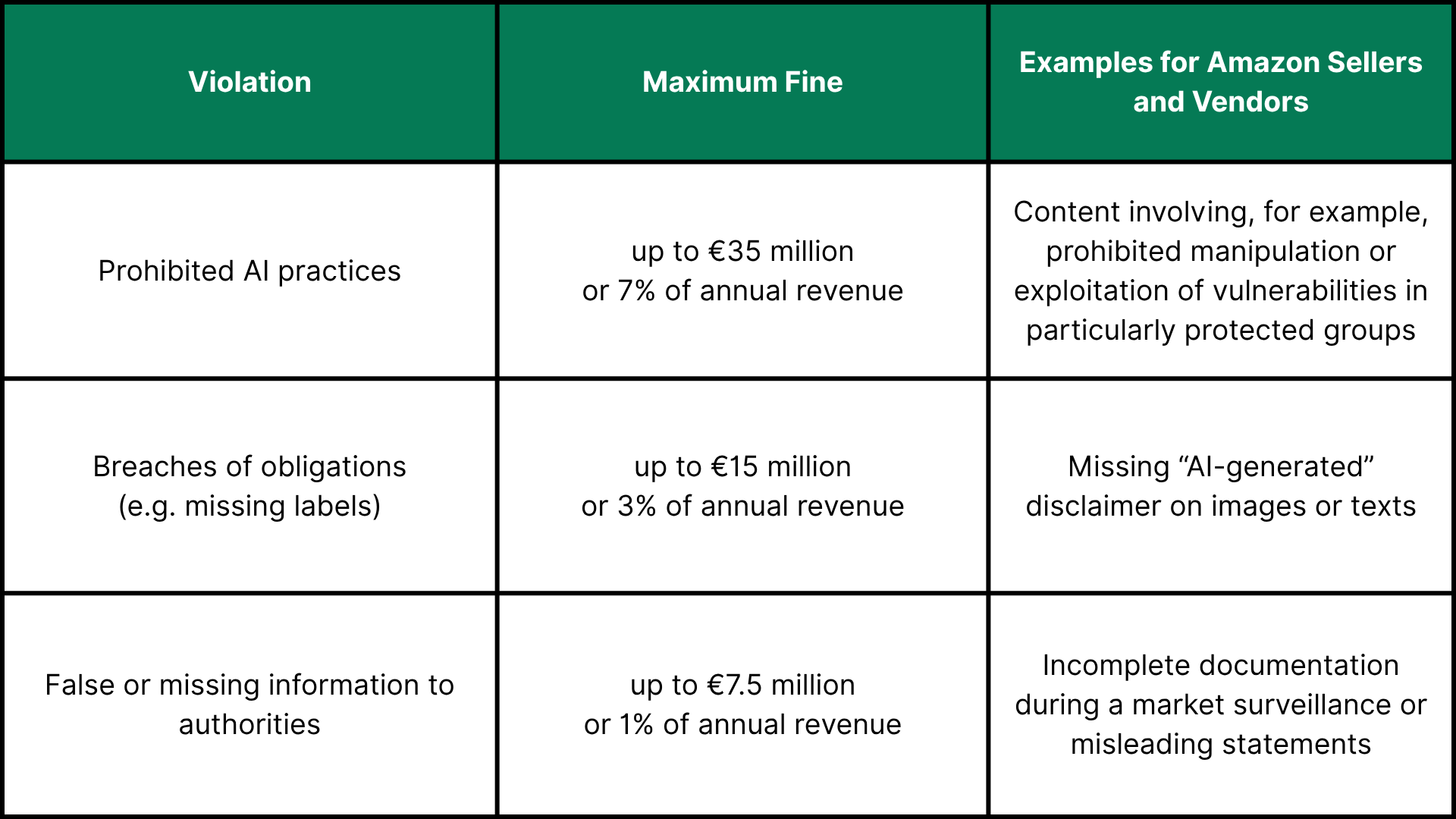EU AI Act 2025: What Amazon Sellers and Vendors Need to Know
With the enforcement of the EU Artificial Intelligence Act (EU AI Act), the European Union has established a unified, legally binding regulatory framework for the use of artificial intelligence. The regulation aims to promote technological innovation while ensuring safety, transparency, and the protection of fundamental rights in connection with AI systems. The EU AI Act follows a risk-based approach: the greater the potential risk of harm posed by an AI system, the stricter the corresponding requirements.
Amazon Sellers and Vendors who use AI-powered tools to generate text and image content are now subject to specific regulations. Key areas include transparency obligations and proof of sufficient AI competency. This article provides an overview of the core requirements of the EU AI Act and outlines the resulting obligations for Amazon Sellers and Vendors. Learn which requirements will apply to your business and how to prepare for them in compliance with the law.
Attorney Dennis Tölle from the law firm TWW LAW, specializing in copyright and media law, shares valuable tips for Amazon Sellers and Vendors to safely navigate the EU AI Act.
This article is for general informational purposes only and does not constitute legal advice. While every effort has been made to ensure the accuracy and timeliness of the information, neither the authors nor the publisher accept any liability for errors or omissions. For legal questions regarding the use of AI-generated content or Amazon-compliant implementation, we recommend seeking individual advice from a law firm specialized in this area.
The EU Artificial Intelligence Act
The EU AI Act, which came into force on August 1, 2024, introduces legally binding rules for the use of artificial intelligence across the EU for the first time. The specific obligations are being implemented gradually, depending on the risk category. The higher the risk, the stricter the requirements:
-
Unacceptable Risk: Prohibited AI systems that pose a threat to safety or fundamental rights (e.g., social scoring).
-
High Risk: Permitted with strict conditions for AI systems with significant potential for harm (e.g., in healthcare, hiring, or credit scoring), including extensive documentation and transparency duties.
-
Limited Risk: Specific transparency requirements for most generative AI tools (e.g., chatbots like ChatGPT and image generators like Midjourney) to inform users about AI involvement.
-
Minimal Risk: No regulatory requirements for harmless tools such as spam filters.
The compliance checker helps providers and operators quickly determine whether they are subject to the EU AI Act and what obligations and timelines apply.
This timeline provides an overview of the phased implementation of the EU AI Act regulations:
-
01 August 2024: The EU AI Act enters into force.
-
02 February 2025: Initial provisions come into effect, including:
- A ban on certain AI practices deemed to pose an unacceptable risk;
- An obligation to promote AI literacy, as set out in Article 4, for providers and deployers of AI systems.
-
02 August 2025: Sanctions provisions under Article 99 become applicable.
-
02 August 2026: Transparency obligations under Article 50 apply to limited-risk AI systems, including generative AI tools.
Amazon Sellers and Vendors are increasingly using AI tools for text and image generation. These generative applications are generally classified as “limited-risk” systems. Two core obligations apply to them:
Transparency (Art. 50): Machine-readable labelling required from 02 August 2026
AI literacy (Art. 4): Documented training required from 02 February 2025
Transparency Obligations for AI Content: What Applies to Sellers and Vendors?
From August 2, 2026, Article 50 of the AI Act mandates that providers and deployers of certain AI systems include clear transparency disclosures. Providers (e.g., OpenAI) must machine-label AI-generated content; deployers may not remove such markers and in some cases must add visible labels such as “AI-generated” to ensure the artificial nature of content is obvious to both humans and machines.
Definitions under Article 3:
- Provider: means a natural or legal person, public authority, agency or other body that develops an AI system or a general-purpose AI model or that has an AI system or a general-purpose AI model developed and places it on the market or puts the AI system into service under its own name or trademark, whether for payment or free of charge;
- Deployer: means a natural or legal person, public authority, agency or other body using an AI system under its authority except where the AI system is used in the course of a personal non-professional activity.
Thus, Amazon Vendors and Sellers who use AI to create text or images (e.g., via ChatGPT) are considered deployers under the law. According to Recital 133, the following apply to labeling and traceability:

The transparency requirement also applies to Amazon Sellers and Vendors who use AI technologies as part of their daily business operations. Article 50 of the EU AI Act generally applies in the following five scenarios:
-
Interactive AI, such as chatbots that mimic human behaviour
-
Synthetic audio, image, or video content that could be mistaken for real
-
Emotion recognition or biometric categorisation systems
-
Deceptive deepfakes with the potential to mislead
-
Text content aimed at shaping public opinion
The EU AI Act defines a deepfake as “AI-generated or manipulated image, audio or video content that resembles existing persons, objects, places, entities or events and would falsely appear to a person to be authentic or truthful.”
The following illustration by RTR illustrates the information, disclosure and labelling obligations that arise from AI systems with limited risk:

The Transparency obligations affect two parties:
-
AI Providers (e.g., OpenAI, Midjourney): Must ensure outputs are identifiable as artificial via invisible watermarks or metadata.
-
Commercial AI Users (e.g., Amazon Sellers/Vendors): Must not remove these markers and, depending on the case, may need to add visible warnings.
Article 50 (2) obliges providers to label all synthetic audio, image, video, and text outputs in a machine-readable way. This requirement is waived only if the AI tool is used purely for editorial assistance without materially altering content semantics.
If you, as an Amazon Seller or Vendor, use AI tools such as ChatGPT to create product titles, descriptions or simple product images, you are generally not subject to Article 50 – as long as:
- The content isn’t misleading or manipulative.
- No synthetic image falsely represents a product.
- No misleading claims are made due to AI generation.
Amazon Sellers and Vendors should clearly label all deceptively realistic, AI-generated product images and renderings to avoid regulatory and legal risks. Regarding text-based content, attorney Tölle points to a potential exception: “In the case of purely informative content such as product texts, with increasing digital literacy among users and a growing understanding of AI systems, the machine origin of such content could(!) be perceived as obvious. In such cases, the labeling requirement may no longer apply because the requirements of Article 50 are no longer met.”
For Amazon Sellers and Vendors, Article 50 specifically means:
- Check labeling requirements: A synthetic image or video that “may appear falsely authentic” requires a clearly visible notice for consumers – e.g., “AI-generated.”
- Preserve markers: Providers must mark each AI output in a machine-readable manner; operators may not delete this marking.
- Documentation: Attorney Tölle recommends documenting the history of the AI tools and prompts used in order to trace the creation of the content if necessary.
- Editorial review: If humans assume final responsibility for AI texts, the risk of false or misleading information is reduced.
- Transparency towards platforms and authorities: Upon request, operators should be able to disclose which AI tools they use to ensure transparency and compliance.
- Risk of fines: Missing notices or deleted markers can lead to heavy fines (more on this later in the article). Sellers and Vendors must assess which generative content appears deceptively real. Labeling and maintaining watermarks ensures compliance.
Competency Requirements for AI Users
Since February 2, 2025, Article 4 of the EU AI Act requires all providers and deployers of AI systems to ensure that every person using the system possesses sufficient knowledge, skills, and risk awareness regarding AI. This applies regardless of risk class and includes Amazon sellers and vendors using AI tools to generate product content. A 2025 study by the Stifterverband and McKinsey found that although most German companies recognize AI’s potential, practical implementation often lacks, especially in prompting, automation, data-driven decisions, and ethical evaluation.
*“Even though no formal training is mandated, basic internal education and documentation are essential. This applies irrespective of company size or usage frequency, as legal responsibility for compliant AI use lies with every business user,” states Attorney Tölle.
Companies are responsible for documenting implementation and demonstrating compliance if required:

Compliance with the EU AI Act is monitored by national supervisory authorities. In Germany, the Federal Network Agency was appointed in 2024 as the central AI regulatory authority, with the power to conduct random inspections. Attorney Tölle explains: “This doesn’t mean the authority will monitor all AI use. Spot checks in regulatory processes are likely. A ‘best practice’ approach with documented training and basic AI use policies is strongly advised.”
According to the European Commission, the “Living Repository of AI Literacy Practices” can serve as a helpful source of inspiration for training practices.
Relief Measures for SMEs
The EU AI Act is designed to avoid overburdening micro, small, and medium-sized enterprises (SMEs) with its requirements. Accordingly, the legislation includes several relief provisions.
-
Medium-sized enterprises: fewer than 250 employees, less than €50 million in annual turnover
-
Small enterprises: fewer than 50 employees, less than €10 million in annual turnover
-
Micro-enterprises: fewer than 10 employees, less than €2 million in annual turnover
The following special regulations apply to SMEs:
-
Priority access to regulatory sandboxes: SMEs may test AI applications in a protected environment—free of charge, under real-world conditions, and without the risk of immediate sanctions. This includes, for example, AI-based image generation, automated text creation, or chatbots.
-
Reduced costs and fees: Compliance assessments and potential fines are set at proportionate levels for SMEs.
-
Simplified documentation requirements: SMEs are provided with specialized templates for technical documentation that are less burdensome. For purely informational use cases like product descriptions, the requirement for transparency labeling is generally assessed more leniently – particularly when the machine-generated origin is considered apparent.
-
Tailored training and communication: Targeted information resources and advisory channels are made available to SMEs to support practical implementation.
-
Proportionate obligations for GPAI models: For general-purpose AI models (e.g., GPT-3.5) used by SMEs, obligations are relaxed compared to those applied to models with systemic risk.
The AI Act acknowledges the specific needs of SMEs and provides practical exemptions, streamlined procedures, and financial relief. Amazon Sellers and Vendors can also benefit from these lower legal thresholds when working with generative AI. By easing documentation and transparency obligations, the AI Act significantly lowers the barrier to entry for AI-driven processes. Further details are available in the SME-specific provisions of the EU AI Act.
Penalties for Non-Compliance with the EU AI Act
Article 99 of the EU AI Act addresses the sanctions that will come into effect as of August 2, 2025. These outline a tiered system of fines linked to the company’s global annual turnover:

Regulatory authorities determine the exact fine based on severity, intent, repeat offenses, and cooperative behavior. Proportional reductions apply for small and medium-sized enterprises. In addition to monetary penalties, authorities may withdraw AI systems from the market, mandate changes, or order product recalls if a serious risk is identified.
Pros and Cons of the EU AI Act for Amazon Vendors and Sellers
The EU AI Act promotes the responsible use of AI. For Amazon Vendors and Sellers, it brings not only opportunities but also some challenges. The following overview highlights where AI use offers potential – and where it introduces new obligations.
Advantages
-
Boosts customer trust: Clear transparency obligations foster confidence.
-
Efficiency and scalability: Automated content creation remains viable – just in a compliant way.
-
Development of AI competency: Training obligations enhance internal understanding of AI and increase the effectiveness of AI-powered processes.
-
Competitive edge through early adoption: Businesses that implement labeling and review protocols early can position themselves as leaders in responsible AI use.
Disadvantages
-
Compliance costs: New requirements such as quality assurance, labeling duties, and employee training lead to higher operational expenses.
-
Administrative burden: Manual reviews, documentation, and organizational adjustments consume personnel resources.
-
Marketing limitations: Visible labels may affect the aesthetic appeal of content.
-
Potential fines: Non-compliance can result in significant financial penalties.
The EU AI Act establishes clarity and standards in the use of AI – this can enhance customer trust and improve content quality. However, Amazon Sellers and Vendors must efficiently integrate review and labeling processes. Those who overcome the initial costs and administrative effort can continue scaling their AI use and gain an advantage over less-prepared competitors.
Amazon’s Obligations Under the EU AI Act
If Amazon uses its own generative models, the company qualifies as a provider and is therefore subject to Article 50. This means Amazon must regularly review and, if necessary, update its AI-powered tools to remain compliant with the law.
For Sellers and Vendors, this implies that Amazon – as a platform – may introduce specific requirements to ensure compliance. These could include input fields for declaring “AI-generated content” or automated checks to detect AI-generated images.
Amazon’s Guidelines on AI-Generated Content on the Marketplace
As of July 2025, Amazon’s style and product image guidelines contain no explicit provisions regarding the permissibility of AI-generated content. However, since Amazon provides its own AI tools and actively promotes their use, it can be assumed that AI-generated images and texts are generally accepted on the platform.
Amazon itself emphasizes that the use of AI-powered tools significantly reduces the workload for sellers:

What matters most is that image content complies with Amazon’s official guidelines. The main image of a listing must show the actual product in its true form; renderings, abstract illustrations, or symbolic representations are prohibited. AI-generated images may only be used if they visually resemble a real photograph and do not contain misleading elements such as accessories not included with the product, unrealistic backgrounds, or distorted presentations. The key requirement is that the image must accurately depict the real, sold product.
You’ll find practical tips and prompts in our Amazon Prompts Guide.
The same applies to product texts: the origin of the text – whether written by AI or manually – is currently irrelevant to Amazon. What matters is that the content complies with Amazon’s content policies.
Amazon’s AI Tools for Sellers and Vendors
In recent years, Amazon has introduced several AI-powered tools that allow sellers to create and optimize product descriptions, images, and videos.
One such example is the “Enhance My Listing” tool, which helps sellers improve product descriptions and automatically fill in missing information. According to Amazon, more than 400,000 sellers worldwide now use this generative assistant to automatically optimize titles, bullet points, and attributes – a clear indication that AI-generated content is actively encouraged on the platform. Sellers can review, modify, or reject these suggestions before incorporating them into their product listings.
With the “AI Image Generator”, sellers can produce high-quality product and lifestyle images that comply with Amazon’s requirements. This tool enables sellers to create lifestyle visuals that present their products in realistic scenarios.
Amazon also offers a “Video Generator”, which transforms a single product image into short, engaging videos. These videos can be used in Sponsored Brands campaigns and help tell the product story in a visually compelling way. Currently, however, this tool is only available in the United States.
Even when using Amazon’s own AI tools, sellers are responsible for ensuring that all content complies with Amazon’s guidelines and does not infringe on any copyrights. For more in-depth information about generative AI on the marketplace, see our article on Amazon AI Tools.
Are There Regulatory Differences Between Sellers and Vendors?
Both Amazon Sellers and Vendors use AI tools in a business context. However, their roles on the marketplace differ fundamentally.
Sellers market products under their own name directly on Amazon and, under the AI Act, are considered deployers of AI systems. This means that if they use AI-driven applications to create content, they themselves are responsible for complying with legal obligations – such as those related to transparency, risk management, or documentation. Vendors, on the other hand, sell their products to Amazon, which then markets them independently. At first glance, this might suggest that Amazon bears the regulatory responsibility. However, this assumption is too simplistic: Vendors also qualify as deployers under the EU AI Act – specifically when they independently use AI systems to create and distribute content such as product images or descriptions.
“Regulatory obligations do not apply only to publicly visible sellers, but also to vendors insofar as they generate AI-based content themselves and distribute it as part of their business activities,” explains attorney Tölle.
The legal framework of the EU AI Act is not based on the business model but solely on the actual use and control of the AI system in question. Any differences in platform practice – such as stricter documentation requirements for vendors – do not stem from legal provisions, but rather from Amazon’s specific compliance strategies.
Checklist: 7 Immediate Actions for Legally Compliant AI Use in Your Business
The EU AI Act sets out clear requirements that are crucial for the legally compliant use of AI. The following measures are recommended for Amazon Sellers and Vendors to minimize legal risks when working with AI tools:
Conclusion
Starting in 2025/26, the EU AI Act will introduce new binding regulations for the use of artificial intelligence—including for Amazon Sellers and Vendors. At its core are transparency obligations for AI-generated content (Article 50) and the requirement to demonstrate adequate AI competency (Article 4).
Anyone using AI to create product images, titles, or descriptions must ensure full compliance—through internal policies, clear labeling, human quality assurance, and ongoing staff training. Although simplified requirements apply to small and medium-sized businesses, lack of awareness does not protect against penalties.
The regulatory landscape is evolving: delegated acts, guidelines, and national implementation measures will continue to be refined through 2026. Amazon Sellers and Vendors should therefore closely monitor developments around the EU AI Act, maintain flexible internal processes, and seek legal counsel early when in doubt.
The EU AI Act not only mandates a responsible approach to AI, but also offers a strategic opportunity to position your business as transparent and forward-looking. Those who establish the necessary structures early will benefit in the long term and remain on solid legal ground. Amazon Sellers and Vendors should view the EU AI Act not as a burden, but as a chance to professionalize operations and build lasting customer trust.
FAQ
What is the EU Artificial Intelligence Act (EU AI Act)?
The EU AI Act is a law passed by the European Union that sets binding rules for the use of artificial intelligence. It regulates the deployment of AI systems and their outputs.
What does the EU AI Act mean for Amazon sellers and manufacturers?
Since February 2025, companies must ensure that their personnel are trained in the use of AI systems (Article 4 of the AI Act). Starting August 2026, Article 50 of the Act will introduce transparency requirements for AI-generated content. Amazon sellers and manufacturers using AI to create product texts or images must not remove labels set by the providers and, under certain conditions, must add a visible disclosure.
How can Amazon sellers and manufacturers ensure compliance with the EU AI Act?
Sellers and manufacturers should inventory their AI tools, establish internal policies, monitor the labeling of AI-generated content, implement human oversight, and continuously follow regulatory developments related to the EU AI Act.
Do I have to label AI-generated content on Amazon?
As of Q1/2025, there is no mandatory labeling requirement for AI-generated content on Amazon. However, beginning in August 2026, Article 50 of the EU AI Act will apply: AI system providers must ensure that such content is clearly labeled within the EU.
Does the AI competency requirement apply even with occasional or basic use of AI tools?
*“Yes, the obligation to promote AI competency applies even with occasional or simple use of AI tools – such as generating product descriptions or images. What matters is that sellers are able to understand how the AI systems they use function, what risks they pose, and how to handle them responsibly,” explains attorney Tölle.
More articles that may interest you:
Subscribe to Newsletter
Get the latest Amazon tips and updates delivered to your inbox.
Wir respektieren Ihre Privatsphäre. Jederzeit abbestellbar.
Related Articles
Amazon Project Zero - Together Against Trademark Infringements
With Amazon Project Zero, Amazon helps brand owners uncover brand infringements. The tool is intended to be a joint offensive against plagiarism, in which Amazon and sellers contribute equally to success.

Trutz Fries
